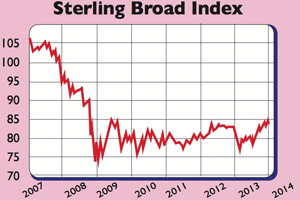
The pound’s rebound on foreign-exchange markets has been one of the most closely watched trends over the past few months. Sterling has jumped to a five-year high against a basket of major trading partners’ currencies on a trade-weighted basis (see chart).
It is at a two-and-a-half-year high of $1.64 against the US dollar, having gained more than 10% since last summer. Against the euro it has reached a 12-month high of €1.21.
The pound could now hurt growth by making exports expensive. The Bank of England worries that “any further substantial appreciation” could hamper the recovery. Clothing retailers Burberry and Asos warned that the strong pound was starting to affect their foreign sales.
The main driver of the currency’s strength has been the turnaround in the economy. Recent data have been unexpectedly strong, and Britain’s impressive growth has made markets look forward to eventual interest-rate hikes.
Only America, which is recovering even faster, is likely to raise rates before Britain, says Capital Economics. In Europe, monetary policy is likely to become even looser, if it changes at all.
Part of the reason for sterling’s recent buoyancy is that investors are starting to wonder whether interest-rate hikes could come sooner rather than later, as Fxstreet.com points out. The Bank of England has said it won’t consider raising rates until unemployment has fallen to 7%. But the rate is already very close to this level and is set to hit it long before 2016 – when the Bank had originally expected it to happen.
Surging house prices may also be fuelling anticipation of rate rises, to prevent a bubble. The Bank’s governor, Mark Carney, “has been caught out by the strength of the labour market [and] appears to be making the same mistake with the housing market”, says Larry Elliott in The Guardian.
But Carney could well keep a lid on sterling by lowering the unemployment target or making it clearer that rates won’t rise for a long time, even if it hits 7%. The decline in inflation gives him more scope to keep rates lower longer than the markets anticipate, says Morgan Stanley.
Given this, and the fact that the US might raise rates before Britain, sterling will most likely weaken slightly against the dollar. With Europe still weak, it could make further, albeit unspectacular, gains against the euro.